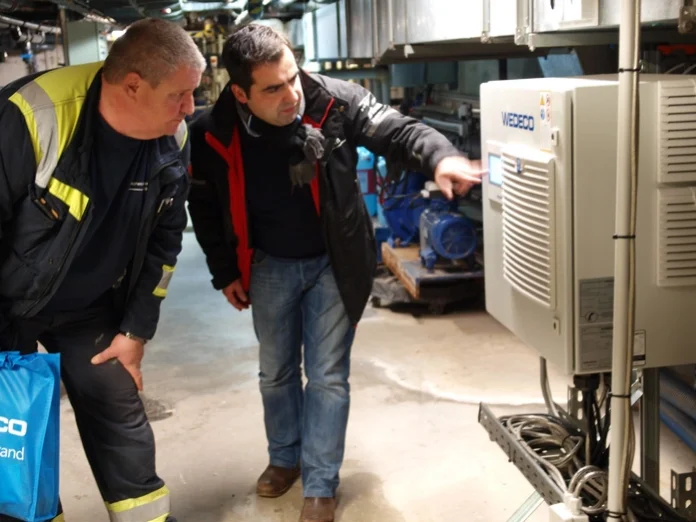Article provided courtesy of Xylem
In public swimming pools, the safe and high quality of the water – along with the well-being of the bathing guests – is a must. This is a great challenge especially when there are many visitors.
An efficient and reliable solution to address water quality concerns is the installation of low-pressure UV systems. A Wedeco system was installed in the water recreational facility, H2O, of the Herford (Germany) Public Utility Company (Stadtwerke Herford). The chloramine load was reduced and the water quality was guaranteed – in an energy-efficient manner – even with an influx of bathers. At the same time, the system used by the Stadtwerke Herford consumes about 10% of the total energy required when compared with an alternative mediumpressure system, as recommended by DIN 19643.
Task
Even with a high number of visitors, the limit values for chlorine compounds and other substances in the water must be maintained without extra effort. In particular, the chloramine load should be reduced, and a more energy-efficient solution should be used.
Compliance with the chloramine limit values without additional measures is a main concern for the efficient operation of a swimming pool or water recreational facility. This saves the operator the cost of fresh water and energy for heating the fresh water, while preventing skin and eye irritation. Stadtwerke Herford initially tested the Wedeco systems through a rental agreement. Those responsible were quickly convinced of the effectiveness and results and decided to assume the system. DIN so far has recommended medium-pressure UV systems, despite the much higher energy consumption.
Low-pressure UV system efficiently disinfects
The Wedeco UV system was integrated into the water circulation process. “We had extensive consultation, recorded the parameters and designed a tailor-made solution,” said Carlos Silva, area sales manager process technology for Xylem. In H2O, a Wedeco BX650e (flowrate of 850m³/h) and a Wedeco Spektron 900e (flowrate of 99 m³/h) are now working invisibly in the background.
“Shortly after the systems had been taken into use, we received feedback from our staff that the odor nuisance had noticeably decreased,” reported Friedrich Peters, head of the H2O technical team. In addition, the Stadtwerke’s laboratory management team checked the values of bound chlorine compounds several times. The limits were only exceeded once during the entire test phase.
The excess in chloramine values took place on a public holiday. On such occasions, the pool and its superfluous values are not considered to be in their normal state due to the maximum load. Since the low-pressure UV system’s operation in this recreational pool facility, the chloramine limit values have been consistently maintained according to DIN standards. It treats the water effectively and energy-efficiently. The additional disinfection provided by the Wedeco systems, on top of the normal chlorine dosage in the pool, represents a process-engineering solution that deviates from the DIN recommendation.
“We have already proven several times that the DIN recommendation is not entirely correct,” emphasized Silva. “Certifications and validations are also provided with this more efficient UV solution.”
Low-pressure systems have several advantages. They require only one-tenth of the total energy required for the mediumpressure solution recommended by DIN. The Wedeco OptiDoseTM control system increases energy efficiency even further. It doses the UV intensity according to the water quality and controls the power consumption.
The amortization rate is fast with continuously running systems, compared with the relatively lower-priced, mediumpressure alternative. A service life of at least 20 years is calculated for the Wedeco units in the Herford swimming pool facility.
As a rule, the Wedeco UV lamps, EcoRay®, function faultlessly for 18 months to two years. Each lamp has a guaranteed lamp life of 14,000 hours – thus, in some cases, twice as long as other solutions.
Less chlorine, synergistic effects
A positive side effect is that double savings are achieved. Because there is less fresh water supplied to comply with the limit values, this also reduces the heating energy requirement needed to bring the pool water to the desired temperature. An increase in chlorination dosage is unnecessary.
The Xylem solution also has a preventive effect through the lasting disinfection. The UV treatment with the Wedeco systems inactivates 99.99% of microorganisms or pathogens, which means they lose their cell division ability and become harmless.
In this way, micro-bacterial accumulation is prevented – for example, at the filter systems – and a contamination of the swimming pool can be avoided from the outset. This, in turn, reduces the need for chlorine and the number of bound chloramines.
“Our low-pressure UV systems break down monochloramines. They are then no longer bound and, therefore, less chlorine must be added to the pool water. Furthermore, this prevents the formation of bi- and tri-chloramines,” explained Silva .






